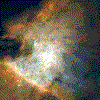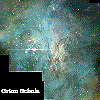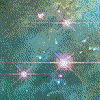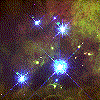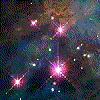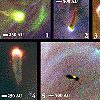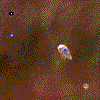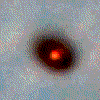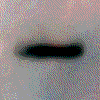Destruction of Proto-Planetary Disks in Orion's Trapezium
The first image shows the center of the Orion nebula. It is composited from a mosaic of 15 separate fields, and covers an area of sky about five percent the area covered by the full Moon. Hubble reveals details as small as 4.1 billion miles across. The Orion nebula is located in the middle of the sword region of the constellation Orion the Hunter, 1500 light-years away.Its four hottest and most massive stars, called the Trapezium, lie near the center of the image. High-speed jets of hot gas spewed by some of the infant stars send supersonic shock waves tearing into the nebula at 100,000 miles per hour. These shock waves appear as thin curved loops, sometimes with bright knots on their end.
The mosaic reveals at least 153 glowing protoplanetary disks (first discovered with the Hubble in 1992, and dubbed "proplyds") that are believed to be embryonic solar systems that will eventually form planets.
The second image (JPG 209 K: click the thumbnail on the left to download a smaller version) shows the four central massive stars of the Trapezium and other surrounding Sun-like stars with a bright head and a tail ponting outwards.
Next three (JPG 95 K, 254 K and 143 K) show the same area in greater detail.
The mosaic (JPG 86 K) show a gallery of star-disk systems, proto-planetary disks or "proplyds" The teardrop shaped star-disk system, known as HST 10, has a central nearly edge on disk with a diameter approximately the same as Pluto's orbit. We are witnessing the destruction of a circumstellar disk wich if otherwise left alone would be a strong candidate for producing planets.
Doug Johnstone (NSERC, University of Toronto), presented at the 1997 AAS meeting in Toronto a theoretical model that suggest that proplyds around young cluster stars may not survive long enough for planets to form within them: "giant planets like Jupiter and Saturn, at comparable distances from their central star, would be ruled out," said Johnstone.
The disk surface is initially heated to temperatures in excess of 1000 Celsius by the impinging radiation, evaporating the surface layer. As the evaporated material flows away from the disk, higher energy photons ionize the gas, heating it to temperatures reaching 10000 degrees Celsius and producing the nebulous glow seen in the images.
Evaporation of the circumstellar disk erodes approximately three moon masses of material per year. As the disk evaporates and shrinks, the erosion rate decreases.
